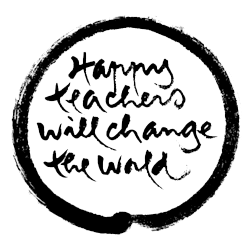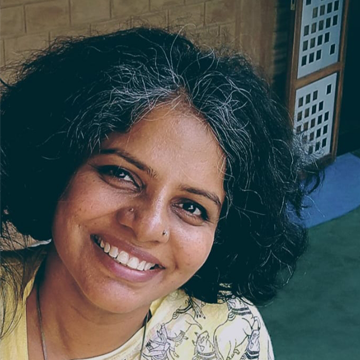
Teacher wellbeing

The inspiration for the work on mindfulness comes from Thich Nhat Hanh – the Zen Buddhist monk. The idea of “Happy Teachers Change the World” became our mantra at Yellow Train. A very interesting characteristic of Thich Nhat Hanh’s practices is that they are very simple. We started by working with just an awareness of our breath – “mindful breathing in and breathing out.” Just becoming aware of our breathing works wonders. We have simple rituals and practices that create a greater space for dialogue for teachers and students. As a result, we have managed to create an environment such that anyone who visits us first notices that in this school, teachers are happy, and children are happy.
A culture of mutual respect
We see each class as a family and the team of teachers also as a family. Just like every member of the family is valuable irrespective of their strengths and weaknesses, every student in the classroom is equally valuable. Each student as a member of the class-family has a strength which is shared with others; and similarly, faces challenges that are recognised and supported by teachers and other students of the class. Teachers consciously keep this in mind while interacting with the students, both during lesson and conversation times.
Teachers and students arrive at classroom norms through mutual discussion. Norms could be, “we respect the speaker and do not interrupt”, “we agree to finish work on time”, “we agree to express any doubts or disagreements in a respectful way”, and so on. By co-creating rules, children start valuing the classroom space. Children are encouraged to ask for conversations / circle time to resolve conflicts. The teacher facilitates the conversation by asking them about what transpired, how the person would have felt about it and how they could deal with the situation differently. Though the desired outcome or result may not be achieved every time, the space to express yourself safely develops trust and serves to strengthen the relationship amongst students.
Space for student participation and questions
Classes are planned in such a way that there is time not just for the teacher to teach, but also for the students to participate in individual and group work. We continued this practice in the online mode to ensure children are not passively sitting or just listening. Teachers make special efforts to encourage the quieter students to speak. They make time to check-in with such students after the entire class exits. Teachers also conduct doubt clearing classes. Once a week, teachers log-in for a session just for the students who want to clarify their doubts. In the higher classes, this is particularly helpful.

Classroom circles and online chats
“Classroom Circles” are an important weekly ritual in the school. Teachers use “Classroom Circles” to follow up on agreed behaviours and rules, address fears and conflicts, inculcate values and strengthen relationships. Some of the questions discussed could be – “what was interesting this week?”,“How did we participate as a class?”, “What were our struggles?”, “What should we do differently”, and so on. This year one of the big missing components for children was not being able to meet up with their classmates and have casual conversations. We tried different methods to fill this gap. One of the teachers developed a practice of allowing the children to chat among themselves without adult supervision and catch up before they started circle time; whereas another teacher created a ‘night-school’ time wherein children stayed up for a couple of hours in the evening to just chit and chat over dinner, in the online classroom space,once again without adult supervision.
Spaces for teachers to meet, share and grow
As a school, just as we focus on our work with children, equal importance is given to the work with teachers. The teachers’ own inner development and well-being along with professional competence determines the effectiveness of their work with children.
-
‘Sangha,’ is a practice of coming together every morning for just about 15 minutes, for some reading or reflective practice which helps us anchor ourselves in the role of teacher. We close it with a verse/affirmation which helps us acknowledge our strength as one big family, before we start our day as teachers. After classes moved online, we don’t meet every day, but we start all teacher meetings with a Sangha. This practice has become an integral part of the school and is a such source of strength for us , that even a new teacher also feels the power of it, within a short time.
-
Teachers new to the school are supported by the experienced teachers in settling into this culture and ethos. New teachers are also assigned buddy teachers who make time to be in regular touch with the new teachers and support their transition.
-
The subject teacher - class teacher relationship is as important as teacher-student relationship. The class teacher constantly remains in touch with the subject teachers, new or old, to discuss the progress of children and how she plans to support their developmental needs.
-
In addition, we also have regular weekly teacher meetings during which we engage in collective reading, present lesson plans, best practices, and also share both the lighter moments from our classroom and the struggles.
Creating time for conversations and becoming aware of our progress and struggles, helps us nurture and strengthen our bonds, as one family (team) of teachers holding all the children in our fold with great care and attention. There is no competition or need to prove myself better than the other, but a true sense of one body of teachers, working towards the betterment of children by developing our own selves. Children also imbibe the same feeling, just by observing us.
Supporting teachers during the pandemic

When we first moved to online teaching, every one of us felt isolated and disconnected. The leadership team members consciously made time to be in touch with everyone, as we hadn’t yet started our weekly meetings. Once we transitioned into online learning spaces, and settled into our own rhythms we resumed our meetings. We used the time to check-in with each other, have a casual conversation, exchange notes on what was happening in the class, what was happening with the teachers and some specific practices. We also shared funny moments in the classroom — for instance, a child would tell us that there is a wi-fi problem so they cannot engage, but we could see the curtain moving in the background. We also had a lot of personal conversations. By finding new ways and practices of staying connected, we all held each other strongly and walked through the new path with a sense of hope and strength. We wrapped up the year with deep gratitude for all the forces that protected us and guided us, and by offering thanks to our dear children and their parents who cooperated and offered their heartfelt support to make the transition possible.
